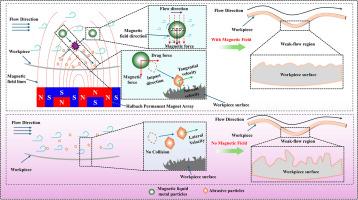Surface uniformity enhancement in artificial joint polishing via halbach array-assisted magnetic liquid metal abrasive flow
IF 6.3
2区 材料科学
Q2 CHEMISTRY, PHYSICAL
引用次数: 0
Abstract
To overcome surface non-uniformity issues in abrasive flow polishing of complex-curvature artificial joints, a Halbach array-assisted magnetic liquid metal abrasive flow polishing method is proposed. Magnetic nanoparticles are introduced into a liquid metal carrier to form a magnetically responsive medium, which enables precise control over abrasive particle migration in weak-flow regions through the single-sided enhanced magnetic field generated by the Halbach array. Numerical simulations indicate that at a flow velocity of 3 m/s, the average velocity in weak-flow regions increases from 1.29 to 1.51 m/s, while the average surface pressure rises from 9288 Pa to 14,308 Pa. Turbulent kinetic energy and pressure–velocity (PV) values increase by 150% and 83.3%, respectively. Erosion analysis demonstrates a 145% improvement in material removal efficiency in weak-flow regions, effectively reducing polishing blind regions by enhancing particle dynamics and energy transfer. Experimental validation corroborates these numerical findings. Surface roughness in weak-flow regions decreases from 121 nm to 72 nm, corresponding to a 40.5% reduction. The maximum surface roughness variation between different regions decreases from 52.2 nm to 13.6 nm, indicating a 73.9% improvement in polishing uniformity. These results highlight the significant advantages of this method in enhancing both polishing efficiency and uniformity for complex biomedical surfaces.

利用halbach阵列辅助磁性液态金属磨粒流提高人工关节抛光表面均匀性
针对复杂曲率人工关节磨料流抛光中存在的表面不均匀性问题,提出了一种Halbach阵列辅助的磁性液态金属磨料流抛光方法。磁性纳米颗粒被引入到液态金属载体中,形成磁响应介质,通过Halbach阵列产生的单面增强磁场,可以精确控制磨粒在弱流区域的迁移。数值模拟结果表明,当流速为3 m/s时,弱流区平均流速由1.29 m/s增加到1.51 m/s,平均地表压力由9288 Pa增加到14308 Pa。湍流动能和压力-速度(PV)值分别增加了150%和83.3%。腐蚀分析表明,在弱流动区域,材料去除效率提高了145%,通过增强颗粒动力学和能量传递有效地减少了抛光盲区。实验验证证实了这些数值结果。弱流区的表面粗糙度从121 nm降低到72 nm,降低了40.5%。不同区域之间的最大表面粗糙度变化从52.2 nm减小到13.6 nm,抛光均匀性提高了73.9%。这些结果突出了该方法在提高复杂生物医学表面的抛光效率和均匀性方面的显着优势。
本文章由计算机程序翻译,如有差异,请以英文原文为准。
求助全文
约1分钟内获得全文
求助全文
来源期刊

Surfaces and Interfaces
Chemistry-General Chemistry
CiteScore
8.50
自引率
6.50%
发文量
753
审稿时长
35 days
期刊介绍:
The aim of the journal is to provide a respectful outlet for ''sound science'' papers in all research areas on surfaces and interfaces. We define sound science papers as papers that describe new and well-executed research, but that do not necessarily provide brand new insights or are merely a description of research results.
Surfaces and Interfaces publishes research papers in all fields of surface science which may not always find the right home on first submission to our Elsevier sister journals (Applied Surface, Surface and Coatings Technology, Thin Solid Films)
 求助内容:
求助内容: 应助结果提醒方式:
应助结果提醒方式:


